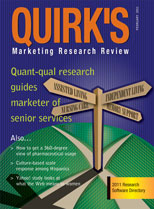Three ways to innovate marketing research
Editor's Note: Barb Murphy is market strategy and planning consultant at The Pert Group, a Bloomfield, Conn., research company. This article appeared in the February 14, 2011, edition of Quirk's e-newsletter.
The face of business is changing. Companies are anxious to get to the core of what motivates consumers. With this enthusiasm for understanding the consumer come higher standards and steeper demands of market researchers. As businesses focus on applying their assets to developing new product, brand and customer experience concepts with cleverly-named processes like "creatology" and "total innovation management," researchers are spurred into action to improve how they meet their clients' needs.
The American Marketing Association's Marketing Research Conference (Atlanta, September 2010) held an "unconference" session to help market researchers think differently about the way they design, implement, synthesize and apply the insights they glean for the organizations they serve.
The session included nearly 30 market research professionals from both the client and supplier sides of the business. Together, they defined the biggest challenges and opportunities they face as researchers in today's marketplace and set about "innovating the research process" in the session I facilitated.
Three core opportunities for innovating market research through process optimization emerged:
1. Create a strategic insights team that includes a cross-section of stakeholders to drive an integrated insights strategy to address business challenges and opportunities.
By focusing diverse internal and external stakeholders on agreed-upon goals, companies can more effectively align interests; strengthen cross-team relationships; and save time and resources. When teams set objectives and expectations up front, market research is better focused and results are more relevant to the desired outcomes. Objections can be addressed early in the process to open minds to opportunities. Early distribution of research insights allows teams to engage in and take ownership of the process. When a cross-section of stakeholders is brought into the process from the beginning, these work sessions can be more effective and efficient.
2. Improve the value and sustainability of each individual research initiative by designing a knowledge-mining system to house and access a comprehensive knowledge base.
Many organizations have abundant data but lack a way to aggregate findings to drive change, improvement and collaboration. By designing a system that can synthesize and broadly disseminate research efforts, companies have the opportunity to reduce duplication, gain new insights and create stronger communication with internal and external partners. There are a variety of ways to create a knowledge management system. These include use of private social networks and content management tools that store research summaries and data in a central location. Overall, a knowledge management tool allows the research process to be more cost-effective and -efficient beyond the lifetime of any one project by adding value and lowering costs; creating new insights; and eliminating duplication.
3. Re-engineer the pricing strategies used in research today by adopting a value-based pricing model.
Participants in the session agreed that there are opportunities for research organizations to adopt a value-based pricing component in place of the typical project-based approach, such as a hybrid service arrangement that integrates the consultative nature of an agency retainer model with elements of a project-based service model. If market research results in truly innovative concepts, then perhaps value-based pricing components can be adopted. For research organizations, being involved as an insights strategy partner is an important component in the success of this model. Enhancing collaboration between internal and external stakeholders, and between research and marketing professionals, allows for greater alignment; focuses knowledge; reduces costs; and empowers teams to act decisively and efficiently.
Understand and agree upon
The unconference group identified several ways to involve stakeholders, engage them in the process and deliver actionable results. On the research design process, both the organization and the researcher must clearly understand and agree upon the exact business issue that is driving the need for new insights and how those insights will be applied. To effectively take action on research findings it's critical to involve all audiences - external and internal - who can share knowledge on what's working, what's not and how insights can be used to drive new ways of thinking, collaboration and innovation.
